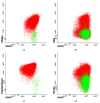Commonly Assessed Markers in Childhood BCP-ALL Diagnostic Panels and Their Association with Genetic Aberrations and Outcome Prediction
- PMID: 36011285
- PMCID: PMC9407579
- DOI: 10.3390/genes13081374
Commonly Assessed Markers in Childhood BCP-ALL Diagnostic Panels and Their Association with Genetic Aberrations and Outcome Prediction
Abstract
Immunophenotypic characterization of leukemic cells with the use of flow cytometry (FC) is a fundamental tool in acute lymphoblastic leukemia (ALL) diagnostics. A variety of genetic aberrations underlie specific B-cell precursor ALL (BCP-ALL) subtypes and their identification is of great importance for risk group stratification. These aberrations include: ETV6::RUNX1 fusion gene, Philadelphia chromosome (BCR::ABL1 fusion gene), rearrangements of the KMT2A, TCF3::PBX1 fusion gene and changes in chromosome number (hyperdiploidy and hypodiploidy). Diagnostic panels for BCP-ALL usually include B-cell lineage specific antigens: CD19, CD10, CD20, maturation stage markers: CD34, CD10, CD38, TdT, IgM and other markers useful for possible genetic subtype indication. Some genetic features of leukemic cells (blasts) are associated with expression of certain antigens. This review comprehensively summarizes all known research data on genotype-immunophenotype correlations in BCP-ALL. In some cases, single molecules are predictive of particular genetic subtypes, i.e., NG2 with KMT2A gene rearrangements or CD123 with hyperdiploidy. However, much more information on possible genotype or prognosis can be obtained with wider (≥8-color) panels. In several studies, a quantitative antigen expression scale and advanced statistical analyses were used to further increase the specificity and sensitivity of genotype/immunophenotype correlation detection. Fast detection of possible genotype/immunophenotype correlations makes multicolor flow cytometry an essential tool for initial leukemia diagnostics and stratification.
Keywords: ETV6::RUNX1; KMT2A; TCF3::PBX1; acute lymphoblastic leukemia; flow cytometry; hyperdiploidy; hypodiploidy.
Conflict of interest statement
The authors declare no conflict of interest.
Figures

Similar articles
-
Flow cytometric predictive scoring systems for common fusions ETV6/RUNX1, BCR/ABL1, TCF3/PBX1 and rearrangements of the KMT2A gene, proposed for the initial cytogenetic approach in cases of B-acute lymphoblastic leukemia.Int J Lab Hematol. 2019 Jun;41(3):364-372. doi: 10.1111/ijlh.12983. Epub 2019 Feb 7. Int J Lab Hematol. 2019. PMID: 30730614
-
Machine Learning Based Analysis of Relations between Antigen Expression and Genetic Aberrations in Childhood B-Cell Precursor Acute Lymphoblastic Leukaemia.J Clin Med. 2022 Apr 19;11(9):2281. doi: 10.3390/jcm11092281. J Clin Med. 2022. PMID: 35566407 Free PMC article.
-
Impact of immunophenotypic characteristics on genetic subgrouping in childhood acute lymphoblastic leukemia: Tokyo Children's Cancer Study Group (TCCSG) study L04-16.Genes Chromosomes Cancer. 2020 Oct;59(10):551-561. doi: 10.1002/gcc.22858. Epub 2020 Jul 16. Genes Chromosomes Cancer. 2020. PMID: 32368831
-
Emerging molecular subtypes and therapies in acute lymphoblastic leukemia.Semin Diagn Pathol. 2023 May;40(3):202-215. doi: 10.1053/j.semdp.2023.04.003. Epub 2023 Apr 9. Semin Diagn Pathol. 2023. PMID: 37120350 Review.
-
BCR-ABL1-like acute lymphoblastic leukaemia: From bench to bedside.Eur J Cancer. 2017 Sep;82:203-218. doi: 10.1016/j.ejca.2017.06.012. Epub 2017 Jul 12. Eur J Cancer. 2017. PMID: 28709134 Review.
Cited by
-
NG2 Molecule Expression in Acute Lymphoblastic Leukemia B Cells: A Flow-Cytometric Marker for the Rapid Identification of KMT2A Gene Rearrangements.Mediterr J Hematol Infect Dis. 2024 Mar 1;16(1):e2024018. doi: 10.4084/MJHID.2024.018. eCollection 2024. Mediterr J Hematol Infect Dis. 2024. PMID: 38468826 Free PMC article.
-
Immunophenotype of Measurable Residual Blast Cells as an Additional Prognostic Factor in Adults with B-Cell Acute Lymphoblastic Leukemia.Diagnostics (Basel). 2022 Dec 21;13(1):21. doi: 10.3390/diagnostics13010021. Diagnostics (Basel). 2022. PMID: 36611312 Free PMC article.
-
Microfluidic Affinity Selection of B-Lineage Cells from Peripheral Blood for Minimal Residual Disease Monitoring in Pediatric B-Type Acute Lymphoblastic Leukemia Patients.Int J Mol Sci. 2024 Oct 2;25(19):10619. doi: 10.3390/ijms251910619. Int J Mol Sci. 2024. PMID: 39408948 Free PMC article.
-
Subclassification of B-acute lymphoblastic leukemia according to age, immunophenotype and microenvironment, predicts MRD risk in Mexican children from vulnerable regions.Front Oncol. 2024 Jan 5;13:1304662. doi: 10.3389/fonc.2023.1304662. eCollection 2023. Front Oncol. 2024. PMID: 38250553 Free PMC article.
-
Cytogenetic finding of simultaneous inversion of chromosome 14 and tetrasomy 8 in a Pediatric B-Lymphoblastic Leukemia-a case report.Mol Cytogenet. 2025 Jul 18;18(1):15. doi: 10.1186/s13039-025-00715-6. Mol Cytogenet. 2025. PMID: 40682071 Free PMC article.
References
-
- Chulián S., Martínez-Rubio Á., Pérez-García V.M., Rosa M., Blázquez Goñi C., Rodríguez Gutiérrez J.F., Hermosín-Ramos L., Molinos Quintana Á., Caballero-Velázquez T., Ramírez-Orellana M., et al. High-Dimensional Analysis of Single-Cell Flow Cytometry Data Predicts Relapse in Childhood Acute Lymphoblastic Leukaemia. Cancers. 2020;13:17. doi: 10.3390/cancers13010017. - DOI - PMC - PubMed
-
- Chen D., Zheng J., Gerasimcik N., Lagerstedt K., Sjögren H., Abrahamsson J., Fogelstrand L., Mårtensson I.-L. The Expression Pattern of the Pre-B Cell Receptor Components Correlates with Cellular Stage and Clinical Outcome in Acute Lymphoblastic Leukemia. PLOS ONE. 2016;11:e0162638. doi: 10.1371/journal.pone.0162638. - DOI - PMC - PubMed
-
- Cui L., Gao C., Wang C.-J., Zhao X.-X., Li W.-J., Li Z.-G., Zheng H.-Y., Wang T.-Y., Zhang R.-D. Combined Analysis of IKZF1 Deletions and CRLF2 Expression on Prognostic Impact in Pediatric B-Cell Precursor Acute Lymphoblastic Leukemia. Leuk. Lymphoma. 2021;62:410–418. doi: 10.1080/10428194.2020.1832668. - DOI - PubMed
Publication types
MeSH terms
LinkOut - more resources
Full Text Sources
Research Materials
Miscellaneous

